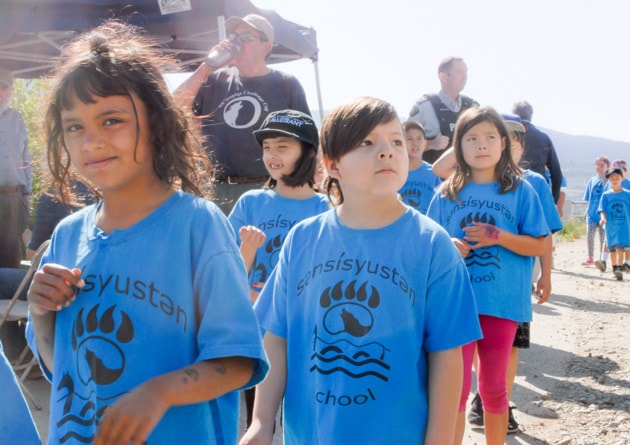The scene on the banks of the Okanagan River Channel Wednesday morning was chaotic as hundreds of children and adults gathered for the ceremonial release of 10,000 sockeye salmon fry into the channel.
“This is a huge success story that we are all celebrating together. How cool is that?” said Chief Jonathon Kruger of the Penticton Indian Band, smiling as he looked over the crowd of more than 400 children from up and down the valley who had come to participate in the ceremony.
 Kruger says, with justification, that this is one of the greatest success stories for bringing a salmon run back to a river. From counts of just three to four thousand in the 1990s, the number of returning sockeye has grown to 250,000 thanks to the work of the Okanagan Nation over the last 14 years.
Kruger says, with justification, that this is one of the greatest success stories for bringing a salmon run back to a river. From counts of just three to four thousand in the 1990s, the number of returning sockeye has grown to 250,000 thanks to the work of the Okanagan Nation over the last 14 years.
“This is years and years of hard work,” said Kruger, noting that this is the second year the salmon fry were supplied by the new Kt cp’alk’ stim fish hatchery, located on PIB land next to Shingle Creek. The $9-million facility is the result of years of hard work itself, with the ONA collaborating with U.S. and Canadian organizations to make it a reality.
The salmon are deeply rooted in Syilx culture, making the return of the sockeye run important for many reasons.
“Salmon are one of our food chiefs. They are a main staple of our food supply, and salmon is so healthy for all humans,” said Kruger. “It is so important for the Syilx to have the salmon come back and we have been working so hard.
“We have the largest inland indigenous fisheries department in all of Canada. We have more biologists in the field in the valley than the province and DFO (Department of Fisheries and Oceans) combined. That is how serious we are taking this.”
The annual release of the salmon fry is always an important event, but Kruger said this one has special significance.
“This year is an important year, because we are releasing salmon fry into Okanagan Lake this year for the first time,” said Kruger. “The province is not happy we are doing that but we are going to do it anyway because that is where they came from.”
Besides restoring the run to its historical extent, Kruger pointed out that getting the fish into the deeper and cooler Skaha and Okanagan Lakes will help more survive.
“The salmon are challenged with global warming. Last year, the heat really hurt the salmon. Osoyoos Lake is beautiful, but it is really shallow,” said Kruger. “We need to get them into Skaha Lake but we also need to get them into Okanagan Lake so they have more room.”
The story isn’t going to stop with the Okanagan River, Kruger said. The Okanagan Nation has plans to expand their restoration program to Arrow Lakes, which is traditional territory for both the Okanagan and the Sinixt peoples.
“We are taking this success story here and we are going to apply it to the Arrow,” said Kruger. “We’re going to make it happen. If we can make it happen here, we can make it happen there.”
